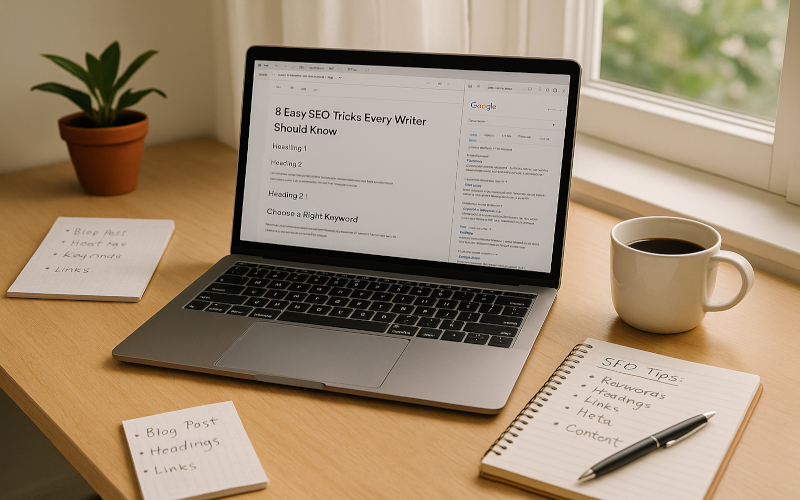Heads up: This post may have affiliate links. As an Amazon Associate, I earn from qualifying purchases.

8 Easy SEO Tricks Every Writer Should Know
Let’s be honest: the letters S-E-O can sound more like a tech buzzword than a helpful tool for writers. But if you’ve ever wondered why some articles get a steady stream of traffic while others sink into silence, the answer is often three little words:
Search Engine Optimization.
Now, before you run for the hills, let me reassure you: you don’t need to be a data scientist or code whisperer to write SEO-friendly content. In fact, great SEO writing is more about being clear, helpful, and intentional than it is about stuffing your piece with awkward keywords or writing like a robot.
SEO, at its heart, is just about making your writing easy to find.
If you’re a writer, whether you blog, freelance, write newsletters, or run a website, understanding a few simple SEO tricks can help your work reach more readers without compromising your voice.
Let’s break down eight easy (yes, easy) SEO tips that will boost your visibility without turning your creativity into a keyword factory.
1. Pick the Right Keyword (Not Too Broad)
Think of keywords as your content’s GPS signal. They tell search engines, “Hey, this is what my article is about!” But choosing the right keyword is key.
Too broad? You’ll disappear in a sea of results. Too obscure? No one’s searching for it.
Instead, look for a sweet spot: a keyword or phrase that has decent search volume, but not so much competition that your post doesn’t stand a chance. These are often called long-tail keywords, and they’re gold for writers.
For example:
-
Bad: “marketing”
-
Better: “email marketing tips for small businesses”
Use free tools like Ubersuggest, Google Trends, or the keyword planner in Google Ads to explore keyword ideas and search volumes.
Once you’ve picked your keyword, build your content around it naturally, not forcefully. Think sprinkle, not shovel.
2. Use Clear, Clickable Headlines
Headlines are the billboard for your writing. If yours doesn’t grab attention, no one’s clicking. The best headlines are:
-
Specific
-
Helpful
-
Emotional (when it makes sense)
-
Keyword-rich, but still human
Let’s take a look:
-
Meh: “Blogging Advice”
-
Better: “7 Blogging Mistakes That Could Be Costing You Readers”
Your headline should make a promise and your article should deliver. Bonus points if it includes a number, a question, or a power word like “easy,” “mistakes,” “strategies,” or “secrets.”
And remember, Google shows about 60 characters of a headline in search results, so keep it punchy and precise.
3. Add Subheadings for Scannability
People don’t read on the internet, they skim. Subheadings are like rest stops on a long drive. They help readers:
-
Quickly find what they’re looking for
-
Navigate long articles
-
Stay engaged
From an SEO standpoint, subheadings (especially using H2 or H3 tags) help Google understand the structure of your content. That makes it easier for search engines to figure out what your post is about.
Make your subheadings helpful, clear, and a little intriguing if possible. For example:
-
Instead of: “Tip #1”
-
Try: “Pick the Right Keyword (Not Too Broad)”
A good subheading should make someone want to keep reading. Think of them as the mini-headlines inside your post.
4. Use Short Paragraphs and Lists
Long, unbroken blocks of text are the fastest way to lose a reader and your SEO rankings. Google favors content that’s easy to read, and that means short paragraphs, bullet points, and numbered lists.
Here’s why lists work:
-
They organize information clearly
-
They catch the eye
-
They’re easy to skim
-
They make dense content digestible
Aim for paragraphs no longer than 2 to 4 sentences. Add lists whenever you’re explaining steps, giving options, or comparing things.
Remember: good formatting isn’t just a design choice it’s an SEO choice.
5. Sprinkle Keywords Naturally
Once you’ve chosen your keyword, it’s tempting to paste it into every other sentence. Don’t. Google got wise to keyword stuffing years ago, and now it can actually hurt your rankings.
Instead, aim for natural keyword use. Include your target keyword:
-
In the headline
-
In the first paragraph
-
In one or two subheadings
-
A few times throughout the article
Also use related phrases and synonyms. This helps search engines understand the context of your piece. For example, if your keyword is “easy SEO tips,” related terms might be:
-
search engine optimization
-
content ranking
-
keyword strategy
-
writing for SEO
Just write like a helpful human who happens to know what Google likes.
6. Add Internal and External Links
Links are the bread and butter of SEO. Why? Because they help Google (and your readers) navigate the internet like a well-marked trail.
There are two types of links you should use in your writing:
-
Internal links: Linking to other posts or pages on your own site
-
External links: Linking to other relevant, high-quality sites
Internal links keep readers on your site longer (which Google likes), and external links show that you’re backing up your info with reputable sources (which Google also likes).
For example, linking to a respected SEO guide like Moz’s Beginner’s Guide to SEO gives your article credibility while helping the reader learn more.
Aim for 2–5 links per 1,000 words, and make sure they’re helpful—not spammy.
7. Write Meta Descriptions Readers Want to Click
Your meta description is the little snippet of text that shows up under your title in search results. Think of it as your elevator pitch.
While meta descriptions don’t directly impact rankings, they absolutely affect click-through rates, which do impact how your content performs over time.
A good meta description:
-
Includes your main keyword
-
Summarizes the article in 1–2 sentences
-
Entices readers to click
Example:
-
“Learn 8 simple SEO tips every writer can use to rank higher, attract more traffic, and write content people actually want to read.”
Make it sound useful, not spammy. You’re not just writing for Google you’re writing for the person deciding whether to click your link or someone else’s.
8. Always Write for People First, Google Second
This is the golden rule of SEO. Never sacrifice clarity, warmth, or readability just to please an algorithm.
Yes, keywords and structure matter. Yes, formatting helps. But at the end of the day, you’re writing for humans. Google’s algorithm gets smarter every year, and its top priority is rewarding quality content not just technically optimized posts.
Great SEO writing is just great writing with a little strategy behind it.
So:
-
Answer real questions
-
Solve actual problems
-
Be generous, be clear, be human
If your readers love your content, Google will too.
SEO Doesn’t Have to Be Scary
SEO might sound technical, but it’s really just thoughtful writing with a few extra ingredients.
Start by choosing the right keyword. Craft a strong headline. Use clear subheadings, clean formatting, and meaningful links. And above all, respect your reader. These are small changes that make a big difference.
You don’t need to chase trends or become an SEO expert overnight. Just build good habits, keep your content helpful, and let Google do the rest.
Because when your writing is both readable and findable, that’s when the magic happens.
